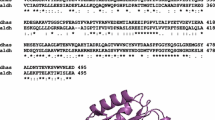Abstract
This study examined the role and physiological relevance of 3-hydroxyisobutyrate dehydrogenase-I (3HIBDHI) of Pseudomonas denitrificans ATCC 13867 in the degradation of 3-hydroxypropionic acid (3-HP) during 3-HP production. The gene encoding 3HIBDH-I of P. denitrificans ATCC 13867 was cloned and expressed in Escherichia coli BL21 (DE3). The recombinant 3HIBDH-I was then purified on a Ni-NTA-HP column and characterized for its choice of substrates, cofactors, metals, reductants, and the optimal temperature and pH. The recombinant 3HIBDH-I showed a high catalytic constant (k cat/K m) of 604.1 ± 71.1 mM/S on (S)-3-hydroxyisobutyrate, but no detectable activity on (R)-3-hydroxyisobutyrate. 3HIBDH-I preferred NAD+ over NADP+ as a cofactor for its catalytic activity. The k cat/K m determined for 3-HP was 15.40 ± 1.43 mM/S in the presence of NAD+ at 37°C and pH 9.0. In addition to (S)-3-hydroxyisobutyrate and 3-HP, 3HIBDH-I utilized l-serine, methyl-d,l-serine, and methyl-(S)-(+)-3-hydroxy-2-methylpropionate; on the other hand, the k cat/K m values determined for these substrates were less than 5.0mM/S. Ethylenediaminetetraacetic acid, 2-mercaptoethanol, dithiothreitol and Mn2+ increased the activity of 3HIBDHI significantly, whereas the presence of Fe2+, Hg2+ and Ag+ in the reaction mixture at 1.0 mM completely inhibited its activity. This study revealed the characteristics of 3HIBDH-I and its significance in 3-HP degradation.
Similar content being viewed by others
References
Paster, M., J. L. Pellegrino, and T. M. Carole (2003) Industrial bioproducts: today and tomorrow. US DOE report. http://www.brdisolutions.com/pdfs/BioProductsOpportunitiesReportFinal.pdf
Ashok, S., S. M. Raj, Y. Ko, M. Sankaranarayanan, S. Zhou, V. Kumar, and S. Park (2013) Effect of puuC overexpression and nitrate addition on glycerol metabolism and anaerobic 3-hydroxypropionic acid production in recombinant Klebsiella pneumoniae ΔglpKΔdhaT. Metab. Eng. 15: 10–24.
Ganesh, I., S. Ravikumar, and S. H. Hong (2012) Metabolically engineered Escherichia coli as a tool for the production of bioenergy and biochemicals from glycerol. Biotechnol. Bioproc. Eng. 17: 671–678.
Arasu, M. V., R. Sarkar, B. S. Sekar, V. Kumar, C. Rathnasingh, J. Choi, H. Song, D. Seung, and S. Park (2013) Isolation of a novel Pseudomonas species SP2 which produce vitamin B12 under aerobic condition. Biotechnol. Bioproc. Eng. 18: 43–51.
Zhou, S., C. Catherine, C. Rathnasingh, A. Somasundar, and S. Park (2013) Production of 3-hydroxypropionic acid from glycerol by recombinant Pseudomonas denitrificans. Biotechnol. Bioeng. DOI: 10.1002/bit.24980.
Zhou, S., R. S. Mohan, S. Ashok, S. Edwardraja, S. G. Lee, and S. Park (2013) Cloning, expression and characterization of 3-Hydroxyisobutyrate dehydrogenase from Pseudomonas denitrificans ATCC 13867. PLoS ONE 8: e62666.
Yao, T., L. Xu, H. Ying, H. Huang, and M. Yan (2010) The catalytic property of 3-hydroxyisobutyrate dehydrogenase from Bacillus cereus on 3-hydroxypropionate. Appl. Biochem. Biotechnol. 160: 694–703.
Chowdhury, E. K., S. Nagata, and H. Misono (1996) 3-hydroxyisobutyrate dehydrogenase from Pseudomonas putida E23: Purification and characterization. Biosci. Biotechnol. Biochem. 60: 2043–2047.
Alber, B. E. and G. Fuchs (2002) Propionyl-coenzyme A synthase from Chloroflexus aurantiacus, a key enzyme of the 3-hydroxypropionate cycle for autotrophic CO2 fixation. J. Biol. Chem. 277: 12137–12143.
Ainala, S. K., A. Somasundar, and S. Park (2013) Complete genome sequence of Pseudomonas denitrificans ATCC13867. Genome Announc. 1: e00257–13.
Sambrook, J. and D. Russell (2001) Molecular Cloning-A laboratory manual. 3rd ed., Cold Spring Harbor Laboratory Press, NY, USA.
Liu, Y., J. Pan, P. Wei, J. Zhu, L. Huang, J. Cai, and Z. Xu (2012) Efficient expression and purification of recombinant alcohol Oxidase in Pichia pastoris. Biotechnol. Bioproc. Eng. 17: 703–710.
Rougraff, P. M., R. Paxton, M. J. Kuntz, D. W. Crabb, and R. A. Harris (1988) Purification and characterization of 3-hydroxyisobutyrate dehydrogenase from rabbit liver. J. Biol. Chem. 263: 327–331.
Den, H., W. G. Robinson, and M. J. Coon (1959) Enzymatic conversion of beta-hydroxypropionate to malonic semialdehyde. J. Biol. Chem. 234: 1666–1671.
Bradford, M. M. (1976) A rapid and sensitive method for the quantitation of microgram quantities of protein utilizing the principle of protein-dye binding. Anal. Biochem. 72: 248–254.
Ramachandran, G. N., C. Ramakrishnan, and V. Sasisekharan (1963) Stereochemistry of polypeptide chain configurations. J. Mol. Biol. 7: 95–99.
Glasel, J. A. (1995) Validity of nucleic acid purities monitored by 260/280 absorbance ratios. BioTechniques 18: 62–63.
Tataurov, A. V., Y. You, and R. Owczarzy (2008) Predicting ultraviolet spectrum of single stranded and double stranded deoxyribonucleic acids. Biophys. Chem. 133: 66–70.
Korge, P. and K. B. Campbell (1993) The effect of changes in iron redox status on the activity of enzymes sensitive to modification of SH groups. Arch. Biochem. Biophys. 304: 420–428.
Tchigvintsev, A., A. Singer, G. Brown, R. Flick, E. Evdokimova, K. Tan, C. F. Gonzalez, A. Savchenko, and A. F. Yakunin (2012) Biochemical and structural studies of uncharacterized protein PA0743 from Pseudomonas aeruginosa revealed NAD+-dependent L-serine dehydrogenase. J. Biol. Chem. 287: 1874–1883.
Njau, R. K., C. A. Herndon, and J. W. Hawes (2001) New developments in our understanding of the beta-hydroxyacid dehydrogenases. Chem. Biol. Interact. 130–132: 785–791.
Author information
Authors and Affiliations
Corresponding author
Additional information
These authors contributed equally to this work.
Rights and permissions
About this article
Cite this article
Lee, P., Raj, S.M., Zhou, S. et al. 3-hydroxyisobutyrate dehydrogenase-I from Pseudomonas denitrificans ATCC 13867 degrades 3-hydroxypropionic acid. Biotechnol Bioproc E 19, 1–7 (2014). https://doi.org/10.1007/s12257-013-0487-x
Received:
Revised:
Accepted:
Published:
Issue Date:
DOI: https://doi.org/10.1007/s12257-013-0487-x



